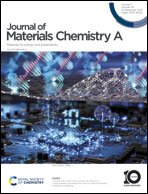Exploring the anisotropic properties of chiral nematic cellulose nanocrystal aerogels: outstanding directional mechanical strength and unexpected surface-dependent thermal conductivity†
Abstract
Understanding the fundamental properties of materials is crucial for expanding their potential applications. Chiral nematic cellulose nanocrystal (CNC) gels and aerogels have been explored in various areas, yet there are significant knowledge gaps in their assembly, structure and properties. In order to fulfill different practical applications, such as in insulation, the thermal conductivity and mechanical strength of CNC aerogels should be studied. Here, we report the directional thermal and mechanical properties of chiral nematic CNC aerogels that originate from their unique anisotropic structure. Unexpected differences of thermal conductivities between the top (0.036 ± 0.001 W m−1 K−1) and bottom surface (0.042 ± 0.002 W m−1 K−1) of chiral nematic CNC aerogel monoliths prepared in vials have been discovered. A time lapse study of the sol–gel preparation process indicated that disturbances to the chiral nematic aligned CNCs during solvent addition are the primary reason for the anisotropy. This conclusion was supported by a comparison between the thermal conductivities of the chiral nematic CNC aerogels obtained from containers with different hydrophobicity, together with the analysis of their microstructures by scanning electron microscopy. The chiral nematic CNC aerogels also showed unprecedented high mechanical strengths via compression tests. The Young's moduli of the samples were determined to be 43.0 ± 2.0 MPa and 8.8 ± 0.3 MPa in the directions parallel and perpendicular to the CNC chiral nematic alignment, respectively. These impressive and directional mechanical properties arise from the highly ordered and anisotropic chiral nematic structure within the aerogels, and were further probed by X-ray microtomography (XMT) analysis under different strains ranging from 0 to 15% applied in directions parallel and perpendicular to the CNC lamellae. The results of the mechanical and thermal studies, combined with structural analysis, have helped to understand the nature of chiral nematic aerogels and will expand their potential applications.



 Please wait while we load your content...
Please wait while we load your content...